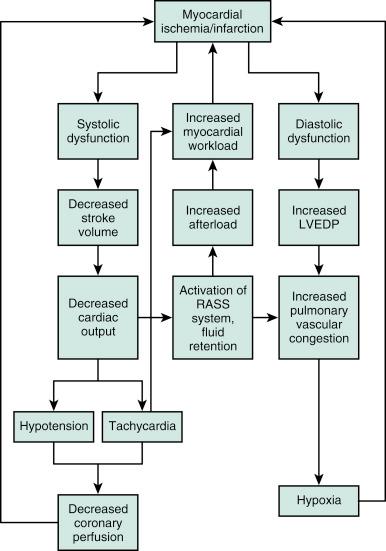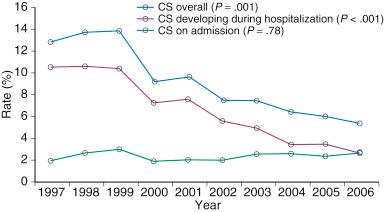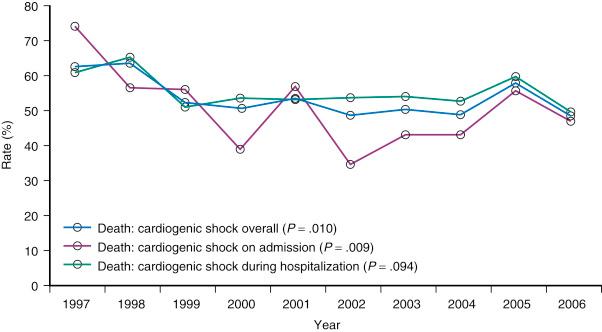Physical Address
304 North Cardinal St.
Dorchester Center, MA 02124
Cardiogenic shock (CS) remains the leading cause of death among patients hospitalized with acute myocardial infarction (AMI).
Left ventricular (LV) dysfunction accounts for most CS in AMI patients. Early restoration of perfusion to the territory supplied by the infarct-related artery is of paramount importance in preventing CS and changing outcomes once it has developed.
The Should We Emergently Revascularize Occluded Coronaries for Cardiogenic Shock (SHOCK) trial and registry demonstrated the mortality benefit of early, immediate revascularization compared with medical stabilization.
Major predictors of improved outcomes with percutaneous coronary intervention (PCI) in CS are time to reperfusion, achievement of vessel patency, and increase in thrombolysis in myocardial infarction (TIMI) flow grade.
The majority of patients who present with CS have multi-vessel disease. Interventions on noninfarct-related artery (IRA) lesions may be beneficial. Patients with coronary anatomy not deemed suitable for PCI should be surgically revascularized.
CS is a treatable illness with a reasonable chance of recovery in the primary PCI era. An early invasive approach can increase both short- and long-term survival, and survivors often regain an excellent quality of life.
The combination of a systolic blood pressure less than 90 mm Hg, elevated intracardiac filling pressures, and target organ damage due to cardiac dysfunction defines cardiogenic shock (CS). Early case series of CS revealed an in-hospital mortality approaching 80%. Advances in intravenous (IV) drug therapy, systems of care, newer circulatory support devices, and more aggressive attempts at coronary revascularization have all led to an improvement in survival, but CS continues to have an in-hospital mortality approaching 50%. To understand which therapies might benefit patients with CS, it is necessary to review the pathophysiology and examine in detail the trials of drugs, circulatory support devices, and percutaneous coronary intervention (PCI).
CS is a state of end-organ hypoperfusion caused by cardiac failure. Manifestations may include cold extremities, decreased urine output (<30 mL/h), alteration in mental status, or both in the setting of low systemic arterial blood pressure. Hemodynamically, CS is characterized by low cardiac output (CO) and systemic arterial hypotension in the setting of normal or elevated left ventricular (LV) filling pressure.
LV pump failure is the primary insult in most forms of CS. LV dysfunction may reflect new irreversible injury, reversible ischemia, damage from prior infarction, or a combination of these. Ventricular pump failure is caused by both systolic and diastolic dysfunction ( Fig. 22.1 ). Systolic dysfunction results in a decreased stroke volume and resultant decreased CO, which clinically presents as a lower blood pressure. The body’s response is an attempt to raise the blood pressure by increasing the heart rate and peripheral vasoconstriction, which although temporarily effective, also leads to increased myocardial work. The combination of the decreasing blood pressure, higher heart rate, and increased myocardial work leads to decreased coronary perfusion that is dependent on diastolic blood pressure and the diastolic filling period, which shortens as the heart rate increases. This decreased coronary perfusion leads to further myocardial ischemia. The lower blood pressure also triggers the renin-angiotensin-aldosterone system (RAAS), which results in fluid retention and peripheral vasoconstriction. These two effects, combined with the aforementioned tachycardia, further increase myocardial workload and contributes to worsening myocardial dysfunction. Finally, diastolic dysfunction leads to an increased LV end-diastolic pressure (LVEDP), which causes pulmonary congestion and hypoxia. The elevation in LVEDP and the lower diastolic blood pressure also contribute to lower coronary perfusion pressure. Both the hypoxia and the lower coronary perfusion pressure result in further myocardial ischemia.

Right ventricular (RV) dysfunction may also cause or contribute to CS. RV failure may limit LV filling via a decrease in CO, ventricular interdependence, or both. Additionally, as the intraventricular septum can account for up to 40% of RV function, proximal left anterior descending (LAD) occlusions that result in poor septal branch coronary blood flow can lead to significant RV dysfunction. Shock caused by isolated RV dysfunction carries nearly as high a mortality risk as shock caused by LV failure. Additionally, the benefit of revascularization was similar in the Should We Emergently Revascularize Occluded Coronaries for Cardiogenic Shock (SHOCK) trial and in the registry in patients with primarily RV dysfunction versus primarily LV dysfunction.
Mechanical complications such as ventricular septal rupture and papillary muscle rupture may lead to CS without severe reduction in LV function. Ultimately, most patients with CS complicating acute myocardial infarction (AMI) develop shock after presenting at the hospital. In some, medication use contributes to the development of shock. Classes of medications used to treat AMI that have been associated with shock include beta-blockers, angiotensin-converting enzyme (ACE) inhibitors, nitrates, diuretics, and morphine.
Whereas severe cardiac dysfunction that might lead to CS has many causes, by far the most common cause of CS in hospitalized inpatients in the United States is coronary artery disease (CAD). The incidence and mortality of patients with CS in the setting of AMI remained unchanged during the 1980s and 1990s despite a progressive decline in the overall mortality of AMI, the development of the coronary care unit and early defibrillation in the 1970s, the routine use of aspirin and β-blockers in the 1980s, and the introduction of reperfusion therapy with thrombolytics in the early 1990s. The mortality associated with an acute coronary syndrome (ACS) and CS started to improve with attempts at percutaneous revascularization ( Figs. 22.2 and 22.3 ).


The SHOCK trial is the largest randomized trial to compare early, immediate revascularization, accomplished by either PCI or coronary artery bypass grafting (CABG), and initial medical stabilization in the setting of CS complicating AMI, which includes reperfusion therapy with thrombolytics. The SHOCK trial and its registry provide insight into the etiology, risk factors, hemodynamic profile, clinical features, timing, and prognosis of CS complicating AMI. Eligible patients had to have an ST-segment elevation myocardial infarction (STEMI) complicated by shock caused by LV failure (mechanical and iatrogenic causes excluded), clinical and hemodynamic confirmation of CS, and shock developing within 36 hours of infarction. Intraaortic balloon pump (IABP) counterpulsation was permitted in both arms. Randomization had to occur within 12 hours of the diagnosis of shock. Patients with severe systemic illness, mechanical complications of myocardial infarction (MI), dilated cardiomyopathy (DCM), and severe valvular heart disease were excluded. A total of 302 patients were randomized in the SHOCK trial; a simultaneous registry prospectively enrolled patients who did not fulfill the eligibility criteria for entry into the trial. The SHOCK trial and registry included patients with mechanical complications of AMI, those with shock secondary to medications, those who presented more than 36 hours after infarction or who were not randomized within 12 hours of shock, and patients with shock diagnosed on clinical grounds alone (no hemodynamic confirmation). A total of 1190 patients were enrolled in this prospective, nonrandomized registry.
Become a Clinical Tree membership for Full access and enjoy Unlimited articles
If you are a member. Log in here